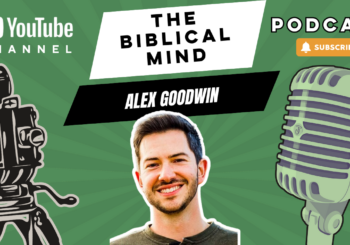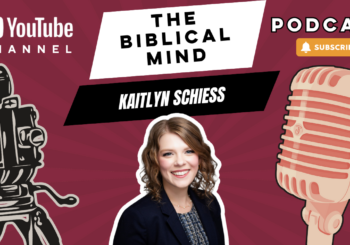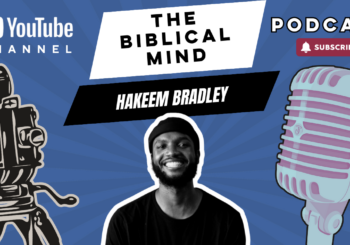Is It Good or Bad to Become Like God?
Many Christians aspire to be “like God” in certain respects—to be loving, just, merciful, wise—and indeed, this might even be considered the chief goal of the spiritual life. We were, after all, created in God’s image, and it often seems like much of what’s wrong in the world is the result of humans not being like God enough. At the same time, you don’t have to read too far into the Bible before getting the picture that humans trying to become like God is also the root of some serious problems.
Enjoying this article? Read more from The Biblical Mind.
The serpent told Eve in the Garden of Eden that eating the forbidden fruit would make her “like God” with respect to a kind of knowledge, and when she and Adam ate the fruit, they ushered in no less than the downfall of the world. So it’s clear that there’s at least some ambiguity in our understanding of godlikeness. But the misunderstanding may run deeper if we assume that we share with the biblical authors some common concept of what “becoming like God” means. In fact, I don’t think we share a common concept. The Bible refuses to answer our question of whether becoming like God is good or bad once-and-for-all because it operates under a fundamentally different assumption of what becoming like God means.
Reading the Bible is a cross-cultural experience. And just as our ideas about law or gender are culturally conditioned, so too are our concepts of divinity and humanity. The question of how to become like God depends on a whole host of assumptions about the nature of humanity, the nature of divinity, and the relationship between the two—assumptions which the modern West and the ancient Near East don’t necessarily share. So before we can answer the ethical question, we have to ask: What does “becoming like God” actually mean in the thought-world of the ancient Near East?
Become Like God—in Being or in Power?
We might be surprised at the fluid picture of divinity we see in the ancient Near East—and, consequently, the Hebrew Bible. The distinction between gods and everything else isn’t as clear as we’d probably expect. According to Jaco Gericke, the word ʾelohim (the most common Hebrew word for god), as well as its related terms ʾel and ʾeloah, can refer to an “almost inordinate variety of phenomena.”1Jaco Gericke, What Is a God? Philosophical Perspectives on Divine Essence in the Hebrew Bible (London: Bloomsbury, 2017), 1. Aside from referring to the God of Israel, ʾelohim as used in the Hebrew Bible can refer to anything considered to take part in the divine realm: beings that would include, in today’s terms, spirits, angels, demons, and semi-gods. Sometimes humans are part of this category; among the term’s more unusual referents in the Bible are the king, Moses, and the deceased spirit of Samuel (Psalm 45:7; Exodus 4:16; 1 Samuel 28:13).
Part of the reason that an assumed “natural” division between categories of divinity and humanity is so difficult to make concerns the ways in which godlikeness itself is understood in the ancient Near East. While the Christian West generally differentiates gods and humans based on the kind of being they essentially are, the ancient Near East differentiated gods and humans based on what they can do.
According to Mark Smith, the worldview that the modern West has inherited from the Christian Middle Ages describes reality in terms of capital-B “Being” and lower-case-B “beings.” That is, every creature that exists derives its existence or being from Being itself, conceptualized as God. To say that a creature exists is to say that it has certain essential characteristics. He contrasts this with the worldview of ancient Levantine cultures, which “largely viewed the use of ʾelohim . . . as a matter of capital-P ‘Power’ and lower-case-P ‘powers’.”2ion: Deities in Cross-Cultural Discourse in the Biblical World (Grand Rapids: Eerdmans, 2010), 14. See also Mark Smith, The Memoirs of God: History, Memory, and Experience of the Divine in Ancient Israel (Minneapolis: Fortress Press, 2004), 162. In other words, to say that a creature exists is to say that it has a certain level of power. ʾElohim is just the word used to designate ultimate, capital-P Power, and the extent to which a creature participates in or is associated with this Power is the extent to which that creature is divine.
Gaining and Losing Divine Status
This is more than just semantics. The difference is subtle, but it occurs at such a fundamental level that its implications are enormous. The fact that divinity is conceived in terms of power rather than being creates an inherent instability in one’s status as either divine or human, because power can always be lost or gained. This instability is explored in numerous ways throughout the literature of the ancient Near East, rife with tales of beings who both gain and lose divine status.
For example, Dimitri Meeks argues that in Egypt one’s divine status is not a natural given but is actualized by rite, and must be maintained by the continuation of rite.3Dimitri Meeks, “Notion de ‘dieu’ et structure du pantheon dans l’Egypte ancienne,” RHR 205 (1988): 425-446; Van der Toorn, “God (I),” DDD, 353. The prophet Isaiah alludes to the Babylonian myth of Helel ben Shahar, who “sought to ascend to heaven, above the divine stars” to make himself like God (Isaiah 14:13–14). At least one Psalm shows that it was possible for divine beings to fall to merely human status as a result of having been expelled from heaven (Psalm 82:7).
It is also conceivable to be divine in greater or lesser degrees. The best-known example is the character Gilgamesh, who was 2/3 divine and 1/3 human. In the Myth of Atraḫasis, humankind’s first ancestor is named Ila-we-e-I-la, or “god-human.”4Gebhard J. Selz, “The Divine Prototypes,” in Religion and Power: Divine Kingship in the Ancient World and Beyond, ed. Nicole Maria Brisch (Chicago: Oriental Institute of the University of Chicago, 2008), 16; W. G. Lambert and A. R. Millard, Atra-Ḫasīs: The Babylonian Story of the Flood (Winona Lake, IN: Eisenbrauns, 1999), 58–59. Elsewhere in Mesopotamia, certain gods (Isis, for example) are more “divine” than others.5Erik Hornung, Der Eine und die Vielen: Ägyptische Gotteslvorstellungen (Darmstadt: WBG, 1971), 53. Also, kings throughout the ancient Near East were sometimes considered as divinities. A fitting example is Narām-Sîn, 23rd c. BCE king of Akkad, who referred to himself as the “God of Akkad.”6Tyson Puthoff, Gods and Humans in the Ancient Near East (Cambridge: Cambridge University Press, 2020), 76–78. He was not born a god, but ascended to godhood via his expansion of the empire. Still, his eventual demise at the hands of Enlil reveals that he was not equal footing with the rest of the divine realm (Narām-Sîn’s famous “Victory Stele” gives you a good sense of this intermediate status visually). Thus, certain humans can share more or less in divinity according to their social status or accomplishments: the power they are able to exercise.
What Does It Mean to Become Like God in the Bible?
What is the upshot of all this for our initial question? “Becoming like God” means something altogether different in a world in which the crossing of the human-divine boundary happens with regularity—where divine identities are not imagined as absolutely fixed but capable of transformation under the appropriate circumstances.
The literature of the Bible explores the ethics of crossing the divine-human boundary in various ways. In the Eden story of Genesis 3, and possibly the stories of the Nephilim and the Tower of Babel, human attempts to become like God are painted more or less as failed acts of rebellion. But other biblical texts seem to imply that at least certain humans can in fact push this boundary successfully—that it may even be in their nature to do so.
The most glaring of these instances comes at the very beginning of the Bible when male and female are created “in the image of” God (Genesis 1:26–27). This concept has a long interpretive history that need not be completely rehearsed here, except to make one observation. Statues of gods throughout the ancient Near East do not merely represent the divine being: they constitute a locus of the divine essence. The god is not symbolized but really present in its image.7See Zainab Bahrani, “Ṣalmu: Representation in the Real,” in The Graven Image: Representation in Babylonia and Assyria (Philadelphia: University of Pennsylvania Press, 2003), 121–148. This is why stealing a god’s statue (affectionately termed god-napping) was such an important part of military conquest throughout ancient Near Eastern history: it meant absolute lack of access of the conquered party to the deity, a direct threat to their very survival.
Ancient Israel forbade these material divine images. In fact, they often made fun of them in comically brutal takedowns that approximate the modern Twitter quote-tweet (see Isaiah 44:9-20). For ancient Israel, the only thing capable of transmitting divine presence in this way was the human person. That is, in the worldview of ancient Israel, the human being occupies the same position with regard to the deity as does the statue of the god in ancient Near Eastern theology.8See Jill Middlemas, The Divine Image: Prophetic Aniconic Rhetoric and Its Contribution to the Aniconism Debate. Tübingen: Mohr Siebeck, 2014). Chapters 1 and 5 especially provide a helpful orientation to this concept.
This dramatically high view of human personhood is supplemented with various stories of particular humans in Israel’s history whose description of union with God sometimes appears to elevate them to divine status, at least temporarily. Take for example the famously enigmatic detail that Moses descends Mt. Sinai after seeing God’s back with either a “glowing” or a “horned” face (Exod. 34:29–35). Though the translation “horned” in Jerome’s Vulgate has often been seen as clear mistranslation (albeit one resulting in some hilarious art), he may actually have been onto something—horns are a widespread signal in ancient Near Eastern iconography of the divinity of their bearers. Hence some interpreters have viewed this biblical episode as an instance of Moses’ divinization.9See Brent Strawn, “The Old Testament and Participation in God (and/in Christ?): (Re-)Reading the Life of Moses with Some Help from Gregory of Nyssa.” Ex Auditu 33 (2017): 25–52.
Another example is the biblical character Jacob, whose two encounters with God have also led later interpreters to speculations about his deification. In Gen 28:10–17, God appears to Jacob in a dream and promises land, descendants, and blessing, revealing a stairway or ladder on which angels of God are ascending and descending. An ancient Near Eastern reader would immediately understand the symbolic importance of this image. For example, several Egyptian pyramid texts reference the idea of a ladder by which a deceased king might reach the divine realm, and certain Mesopotamian ziggurats claim to be points of connection between the human and divine realms.10R. O. Faulkner, The Ancient Egyptian Pyramid Texts (Oxford: Oxford University Press, 1998), 79, 165–166, 227, 296–297; Frederick E. Greenspahn, “A Mesopotamian Proverb and its Biblical Reception,” Journal of the American Oriental Society 114 (1994): 33-38 (36–37). Recognizing such undertones, one early Jewish midrash interprets this passage as referring to Jacob’s intermediate status between humanity and divinity, understanding Jacob himself as the “stairway” connecting heaven and earth.11Genesis Rabbah 68:12. See analysis in Jonah C. Steinberg, “Theosis through Works of the Law: Deification of the Earthly Righteous in Classical Rabbinic Thought,” in Kimberly B. Stratton and Andrea Lieber, eds., Crossing Boundaries in Early Judaism and Christianity: Ambiguities, Complexities, and Half- Forgotten Adversaries (Festschrift A. F. Segal; Leiden: Brill, 2016), 41–73 (56).
If in Genesis 28 Jacob blurs the boundary between human and divine, the fight at the river Jabbok in Gen 32:22–32 provides a clearer picture of the crossing of that boundary. The story goes like this: a mysterious “man” (later revealed as God) starts wrestling with Jacob in the middle of the night, injuring him in the process. It’s a surprisingly even match. Eventually, God pleads to be released, and Jacob agrees only on the condition that he be given a blessing. But this is no modest act of piety. Claus Westermann suggests “blessing” here is best understood as a “transfer of strength,” specifically, the strength held by divine beings which allows them to overpower humans.12Claus Westermann, Genesis 12–36: A Commentary (trans. John J. Scullion, S. J.; Minneapolis: Augsburg Publishing House, 1985), 518.
Jacob also demands to know God’s name. In the highly developed “name theology” of the ancient Near East in which divine names are “virtually hypostatization[s] of deity,” divine names are unable to be known by mortals (Judg 13; Exod 5).13Stephen A. Geller, “The God of the Covenant,” in One God or Many? Concepts of Divinity in the Ancient World, ed. Barbara Porter (Great Chebeague Island, ME: Casco Bay Assyriological Institute, 2000), 306. According to Egyptian theology, a god could lose its power if its name ceased to be a secret.14Claude Traunecker, The Gods of Egypt, trans. D. Lorton (Ithaca, NY: Cornell University Press, 2001), 31. God does ultimately grant the blessing Jacob demands, but the exact nature of this “blessing” remains ambiguous. Is this an allusion to the disclosure of God’s name? Whatever its content, the result of the blessing is Jacob’s immediate recognition of his assailant’s divinity coupled with shock at having survived what is typically a lethal encounter for a human.15George Savran, Encountering the Divine: Theophany in Biblical Narrative (London: Bloomsbury, 2005), 190–203.
When God changes Jacob’s name to Israel in v. 28, he offers a formulaic explanation typically translated as follows: “because you strove with God and with humans and you prevailed.” Yet the phrase might be alternately translated: “because you are like God, you (also) will prevail over humans,” emphasizing the ontological parity between God and Jacob as a result of the match.16This translation depends on 1) understanding the verse as poetry rather than prose, and 2) comparison with Semitic parallels for the rare verbal root śrh, which occurs in the Old Testament only here and in Hosea’s reference to the same story. On understanding the phrase as a poetic couplet, such that Jacob’s actions against God and humans are set in opposition to one another as opposed to paralleled, see Francis I. Andersen, “A Note on Genesis 30:8” JBL 1969 (88/2): 200, and Robert Coote, “The Meaning of the Name Israel,” HTR 65 (1972): 137–142 (137). As for the identification of śrh as the root along with its semantic range, see the following: Nahum M. Sarna, Understanding Genesis (New York: McGraw-Hill Book Company, 1966), 404-405; Thomas Römer, The Invention of God, trans. Raymond Guess (Cambridge: Harvard University Press, 2015), 72; William F. Albright, “The Names “Israel” and “Judah” with an Excursus on the Etymology of Tôdâh and Tôrâh,” JBL 46/3/4 (1927): 151–185 (156). One final note for the Hebrew nerds: here I understand עם to have the function of comparison, as in Ronald J. Williams, Hebrew Syntax: An Outline, 2nd ed (Toronto: University of Toronto Press, 1976), 57. The vav in the final word ותוכל appears to have an emphatic function and may either be rendered “also” or left untranslated. Coote notes the similarity of the line ועם ענשים ותוכל to certain Ugaritic texts, in which “following an adverbial phrase, a yqtl form may be preceded by waw.” Coote, “The Meaning of the Name Israel,” 137.
Regardless of how we choose to translate v. 29, this episode leaves us with a profoundly ambiguous view of Jacob’s relationship to God. This “achievement” is not without consequences, even within the passage itself: Jacob’s encounter leaves him with a physical disability. Additionally, Jacob’s actions here are not always viewed positively by other biblical authors (Hos. 12:4–5). Nevertheless, in this passage, God appears to allow some sort of crossing to take place, granting Jacob a status as something more than human.
***
So, is it good or bad to become like God? As usual, the questions we bring to the Bible from modern Western culture are not so much answered as they are displaced—shown to be arising from intellectual contexts incompatible with the thought-world of the Bible, and thus unanswerable in their current frameworks. The Bible doesn’t answer our question in those terms. What it does do is start with a radically high view of human personhood and then explore the implications of that view through various case studies, out of which a single answer is difficult to construct. These are the narratives that would be taken up by later exegetes in the development of Christian doctrines of theosis or deification, which is generally understood as human participation in the divine nature.17For more specific definitions of theosis, see the various essays in Partakers of the Divine Nature: The History and Development of Deification in the Christian Traditions, ed. Michael J. Christensen and Jeffery A. Wittung (Grand Rapids: Baker, 2007). For a more comprehensive overview of the Old Testament “seeds” of the doctrine of deification, see Jennie Grillo with Caitlin Hubler, “Hebrew Bible/Old Testament,” in The Oxford Handbook of Deification, ed. Paul Gavrilyuk, Andrew Hofer and Matthew Levering (Oxford: Oxford University Press, forthcoming 2023). Clearly there are wrong ways to become like God, but it may be that even these perversions of godlikeness are only possible because of an even more fundamental compatibility between divine and human.
Reading the Bible without regard to its philosophical context is like doing a Hebrew word study by looking only at English translations. Biblical language instructors often bemoan the ignorance of students guilty of this practice, who, they insist, must be taught to enter more fully into the world of the text and realize the distance separating them from it. Understanding the philosophical context of the Bible provides a means of overcoming that distance to a greater degree, preventing interpretive errors resulting from the premise that the text shares the assumptions of its reader. Overcoming such distance is not only necessary for good theological interpretation, but it also deeply shapes the ways we discuss everyday spiritual life. It helps us uncover what might actually be possible for us mere mortals, who, following the example of our biblical forebears, want to become like God.
End Notes
1. Jaco Gericke, What Is a God? Philosophical Perspectives on Divine Essence in the Hebrew Bible (London: Bloomsbury, 2017), 1.
2. Mark Smith, God in Translation: Deities in Cross-Cultural Discourse in the Biblical World (Grand Rapids: Eerdmans, 2010), 14. See also Mark Smith, The Memoirs of God: History, Memory, and Experience of the Divine in Ancient Israel (Minneapolis: Fortress Press, 2004), 162.
3. Dimitri Meeks, “Notion de ‘dieu’ et structure du pantheon dans l’Egypte ancienne,” RHR 205 (1988): 425-446; Van der Toorn, “God (I),” DDD, 353.
4. Gebhard J. Selz, “The Divine Prototypes,” in Religion and Power: Divine Kingship in the Ancient World and Beyond, ed. Nicole Maria Brisch (Chicago: Oriental Institute of the University of Chicago, 2008), 16; W. G. Lambert and A. R. Millard, Atra-Ḫasīs: The Babylonian Story of the Flood (Winona Lake, IN: Eisenbrauns, 1999), 58–59.
5. Erik Hornung, Der Eine und die Vielen: Ägyptische Gotteslvorstellungen (Darmstadt: WBG, 1971), 53.
6. Tyson Puthoff, Gods and Humans in the Ancient Near East (Cambridge: Cambridge University Press, 2020), 76–78.
7. See Zainab Bahrani, “Ṣalmu: Representation in the Real,” in The Graven Image: Representation in Babylonia and Assyria (Philadelphia: University of Pennsylvania Press, 2003), 121–148.
8. See Jill Middlemas, The Divine Image: Prophetic Aniconic Rhetoric and Its Contribution to the Aniconism Debate. Tübingen: Mohr Siebeck, 2014). Chapters 1 and 5 especially provide a helpful orientation to this concept.
9. See Brent Strawn, “The Old Testament and Participation in God (and/in Christ?): (Re-)Reading the Life of Moses with Some Help from Gregory of Nyssa.” Ex Auditu 33 (2017): 25–52.
10. R. O. Faulkner, The Ancient Egyptian Pyramid Texts (Oxford: Oxford University Press, 1998), 79, 165–166, 227, 296–297; Frederick E. Greenspahn, “A Mesopotamian Proverb and its Biblical Reception,” Journal of the American Oriental Society 114 (1994): 33-38 (36–37).
11. Genesis Rabbah 68:12. See analysis in Jonah C. Steinberg, “Theosis through Works of the Law: Deification of the Earthly Righteous in Classical Rabbinic Thought,” in Kimberly B. Stratton and Andrea Lieber, eds., Crossing Boundaries in Early Judaism and Christianity: Ambiguities, Complexities, and Half- Forgotten Adversaries (Festschrift A. F. Segal; Leiden: Brill, 2016), 41–73 (56).
12. Claus Westermann, Genesis 12–36: A Commentary (trans. John J. Scullion, S. J.; Minneapolis: Augsburg Publishing House, 1985), 518.
13. Stephen A. Geller, “The God of the Covenant,” in One God or Many? Concepts of Divinity in the Ancient World, ed. Barbara Porter (Great Chebeague Island, ME: Casco Bay Assyriological Institute, 2000), 306.
14. Claude Traunecker, The Gods of Egypt, trans. D. Lorton (Ithaca, NY: Cornell University Press, 2001), 31.
15. George Savran, Encountering the Divine: Theophany in Biblical Narrative (London: Bloomsbury, 2005), 190–203.
16. This translation depends on 1) understanding the verse as poetry rather than prose, and 2) comparison with Semitic parallels for the rare verbal root śrh, which occurs in the Old Testament only here and in Hosea’s reference to the same story. On understanding the phrase as a poetic couplet, such that Jacob’s actions against God and humans are set in opposition to one another as opposed to paralleled, see Francis I. Andersen, “A Note on Genesis 30:8” JBL 1969 (88/2): 200, and Robert Coote, “The Meaning of the Name Israel,” HTR 65 (1972): 137–142 (137). As for the identification of śrh as the root along with its semantic range, see the following: Nahum M. Sarna, Understanding Genesis (New York: McGraw-Hill Book Company, 1966), 404-405; Thomas Römer, The Invention of God, trans. Raymond Guess (Cambridge: Harvard University Press, 2015), 72; William F. Albright, “The Names “Israel” and “Judah” with an Excursus on the Etymology of Tôdâh and Tôrâh,” JBL 46/3/4 (1927): 151–185 (156). One final note for the Hebrew nerds: here I understand עם to have the function of comparison, as in Ronald J. Williams, Hebrew Syntax: An Outline, 2nd ed (Toronto: University of Toronto Press, 1976), 57. The vav in the final word ותוכל appears to have an emphatic function and may either be rendered “also” or left untranslated. Coote notes the similarity of the line ועם ענשים ותוכל to certain Ugaritic texts, in which “following an adverbial phrase, a yqtl form may be preceded by waw.” Coote, “The Meaning of the Name Israel,” 137.
17. For more specific definitions of theosis, see the various essays in Partakers of the Divine Nature: The History and Development of Deification in the Christian Traditions, ed. Michael J. Christensen and Jeffery A. Wittung (Grand Rapids: Baker, 2007). For a more comprehensive overview of the Old Testament “seeds” of the doctrine of deification, see Jennie Grillo with Caitlin Hubler, “Hebrew Bible/Old Testament,” in The Oxford Handbook of Deification, ed. Paul Gavrilyuk, Andrew Hofer and Matthew Levering (Oxford: Oxford University Press, forthcoming 2023).
Image created by Rubner Durais
Subscribe now to receive periodic updates from the CHT.





